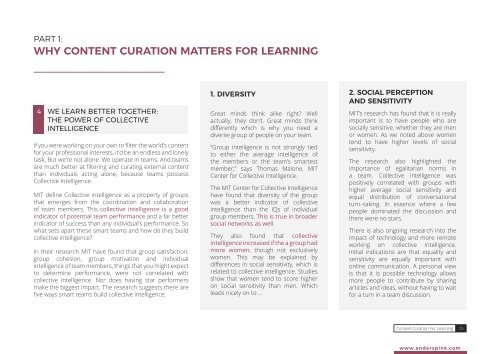CONTENT CURATION FOR LEARNING
2kmo0iW
2kmo0iW
Create successful ePaper yourself
Turn your PDF publications into a flip-book with our unique Google optimized e-Paper software.
PART 1:<br />
WHY <strong>CONTENT</strong> <strong>CURATION</strong> MATTERS <strong>FOR</strong> <strong>LEARNING</strong><br />
4 WE LEARN BETTER TOGETHER:<br />
THE POWER OF COLLECTIVE<br />
INTELLIGENCE<br />
If you were working on your own to filter the world’s content<br />
for your professional interests, it’d be an endless and lonely<br />
task. But we’re not alone. We operate in teams. And teams<br />
are much better at filtering and curating external content<br />
than individuals acting alone, because teams possess<br />
Collective Intelligence.<br />
MIT define Collective intelligence as a property of groups<br />
that emerges from the coordination and collaboration<br />
of team members. This collective intelligence is a good<br />
indicator of potential team performance and a far better<br />
indicator of success than any individual’s performance. So<br />
what sets apart these smart teams and how do they build<br />
collective intelligence?<br />
In their research MIT have found that group satisfaction,<br />
group cohesion, group motivation and individual<br />
intelligence of team members, things that you might expect<br />
to determine performance, were not correlated with<br />
collective intelligence. Nor does having star performers<br />
make the biggest impact. The research suggests there are<br />
five ways smart teams build collective intelligence.<br />
1. DIVERSITY 2. SOCIAL PERCEPTION<br />
AND SENSITIVITY<br />
Great minds think alike right? Well<br />
actually, they don’t. Great minds think<br />
differently which is why you need a<br />
diverse group of people on your team.<br />
“Group intelligence is not strongly tied<br />
to either the average intelligence of<br />
the members or the team’s smartest<br />
member,” says Thomas Malone, MIT<br />
Center for Collective Intelligence.<br />
The MIT Center for Collective Intelligence<br />
have found that diversity of the group<br />
was a better indicator of collective<br />
intelligence than the IQs of individual<br />
group members. This is true in broader<br />
social networks as well.<br />
They also found that collective<br />
intelligence increased if the a group had<br />
more women, though not exclusively<br />
women. This may be explained by<br />
differences in social sensitivity, which is<br />
related to collective intelligence. Studies<br />
show that women tend to score higher<br />
on social sensitivity than men. Which<br />
leads nicely on to …<br />
MIT’s research has found that it is really<br />
important is to have people who are<br />
socially sensitive, whether they are men<br />
or women. As we noted above women<br />
tend to have higher levels of social<br />
sensitivity.<br />
The research also highlighted the<br />
importance of egalitarian norms in<br />
a team. Collective intelligence was<br />
positively correlated with groups with<br />
higher average social sensitivity and<br />
equal distribution of conversational<br />
turn–taking. In essence where a few<br />
people dominated the discussion and<br />
there were no stars.<br />
There is also ongoing research into the<br />
impact of technology and more remote<br />
working on collective intelligence.<br />
Initial indications are that equality and<br />
sensitivity are equally important with<br />
online communication. A personal view<br />
is that it is possible technology allows<br />
more people to contribute by sharing<br />
articles and ideas, without having to wait<br />
for a turn in a team discussion.<br />
Content Curation For Learning<br />
15<br />
www.anderspink.com


